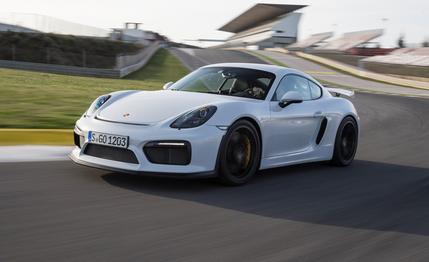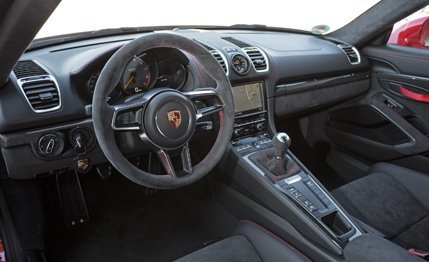 First Drive Review
First Drive Review
The Cayman GT4 manages the neat trick of being both reassuringly familiar and radically different. Nobody with prior experience of any GT-badged 911 is going to be either offended or surprised by the way the über-ized Cayman drives, or the clinical competence with which it deals with the all-important business of being thrashed around a racetrack. Yet, within the rarefied world of Porsche’s GT division, the very fact that the Cayman doesn’t have its engine hung behind its rear axle is a ground-shaking departure from the norm. Then there’s its price tag: $85,595. That might seem like ludicrous money for a Cayman, but this is the cheapest GT-badged Porsche ever sold in America.
The GT4 development team made one critical decision—to give the car an engine from the mainstream side of the Porsche business. In this case, the 3.8-liter flat-six from the 911 Carrera S. Doing this enabled money to be spent on other areas, including giving the Cayman many of the same suspension components as the current 991 GT3. But it does mean an engine that, on paper, lacks some of the high-revving Götterdämmerung we’ve come to expect from a GT-level Porsche.
Just getting the engine into the Cayman required some engineering gymnastics, including turning it 180 degrees so it sits on the other side of the rear axle. Exhaust and intake systems are necessarily new, but the internals are unchanged, and the only other alteration is a lighter flywheel. Officially the GT4 has 385 horsepower—45 more than the Cayman GTS but 15 fewer than the same engine in the 911. But we’ve been assured that output figure represents the very least number of horses any GT4 will ever deliver, likely while climbing a mountain on a hot day.

You’d struggle to improve on the rest of the mechanical specification. The really good news is the presence of a six-speed manual gearbox, proof that the GT3’s PDK didn’t find universal favor. Beyond that there’s a limited-slip differential, Porsche’s torque-vectoring system, and the firm’s active transmission mounts. The front suspension has been pretty much taken straight from the GT3, with the two cars sharing hub carriers, shim-adjustable control arms, and the same steering rack. The rear suspension is similarly beefed up, with ball-jointed links and “helper springs” to pre-tension the main springs. The GT4 sits on track-biased Michelin Pilot Sport Cup 2 tires, and the aerodynamic kit—which replaces the standard Cayman’s pop-up spoiler with a carbon-reinforced polymer wing that looks like it could shave a whale—develops actual downforce. The GT4 is a parts-bin special at heart, but what a bin.
Porsche took us to Portugal to drive the GT4, being keen for us to experience the car (and its aggressive tires) in warm, dry conditions. The company had also booked exclusive use of the very impressive, if little used, Autódromo Internacional Algarve in Portimão. Before that, however, there was the chance to drive the ultra-Cayman on some of the twisting inland roads that give the Algarve region much of its touristic charm, as well as an alarming percentage of its accident statistics.
The GT4 starts off doing a remarkable impression of the 991 GT3. Given the price disparity between the two cars (the GT3 starts at $131,395), this is a good thing. Yes, the mid-engine Cayman’s mass sits much farther forward than that of the 911, but at road speeds it generates so much mechanical grip that you don’t feel much difference beyond the fact that the GT4 is smaller and lighter, making it easier to place on the tight-fitting roads and giving it a greater enthusiasm for obeying directional inputs. The steering feels pretty much identical to the GT3’s—not too heavy, with a strong caster feel and delivering far more information than Porsche allows to pass through the electrical assistance of its regular cars.

Against that, the engine is a slight disappointment. And we stress slight—the GT4 pulls harder than any other Cayman, sounds great while doing so, and delivers the sort of perfectly proportional throttle response that vindicates the decision to stand against the turbocharge-everything orthodoxy that’s sweeping the industry. But while it has plenty of midrange punch, it can’t come close to matching the GT3’s enthusiasm for revs. The Cayman’s fuel cut arrives at 7800 rpm—impressive by modern standards but pretty much exactly where the GT3’s engine starts to do its best work.
The sweet-shifting manual gearbox delivers plenty of compensation. The engineering team acknowledges it’s not as quick as the PDK would have been, but we’d say that it’s at least 400 percent more involving, although—as in all Porsches—the gearing is still toweringly tall (second runs out at 81 mph). Sport mode also brings a rev-matching function if you’re not willing or able to do your own heel-and-toe downshifts.
Predictably, the rest of the GT4 is far harder edged than even the Cayman GTS. The car we drove had optional fixed-back carbon-fiber bucket seats, which would probably start to bite hard after a couple of hours at the wheel, and the suspension never feels anything other than very firm (even with the switchable dampers in their default, softer setting). The upside is mighty body control even over broken road surfaces. And let’s be honest—if you’re looking for ride comfort, this probably isn’t the car for you.